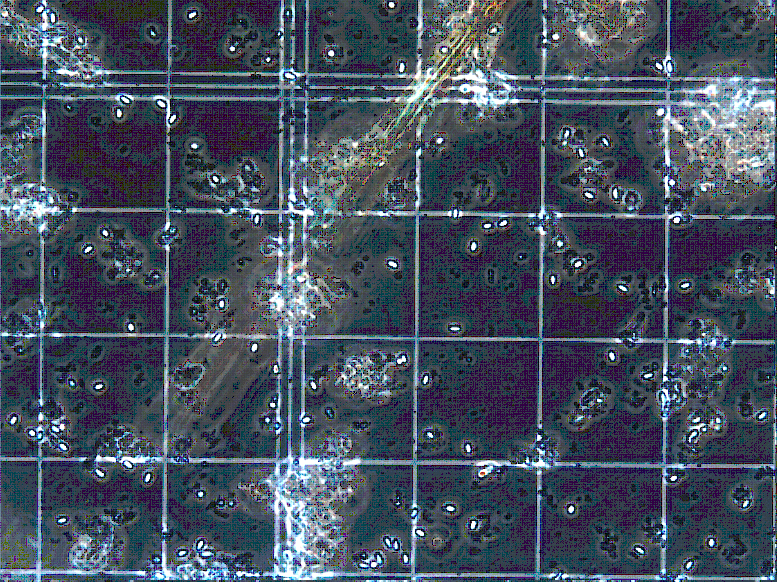The summer sampling period began 10 days ago with the sixteen beekeepers participating in the Bee Informed Partnership. This sampling period places an emphasis on determining Varroa mite and Nosema levels prior to beekeepers treating with medicines this year. Most beekeepers will try to have their mite treatments in 30 days prior to the nectar flow. Out here the flow begins in July when the star thistle blooms. Treatment windows are narrow, making timing and balance critical. One of the many benefits of our program is that we help to provide beekeepers with a history of their hives by inspecting and sampling some of them…
Category: In The Lab
Nosema in the Lab
Looking into the eyepiece of my microscope at the water-mount slides I have prepared, hardly anything I see resembles honey bees. Coincidentally, everything appears a monochromatic amber-gold very close to the color scheme of the inside of a hive. But that is really where the similarity stops. Instead of seeing a humming colony of busy, hard-working bees, my eyes sift through a collection of stationary debris, microbes, and pollen. I am Anna Wallis and I work with Heather Eversole in a lab processing samples taken from hives from all over the United States for honeybee diseases. I am a part of the fantastic team at…
Teamwork
The six most important words: I admit I made a mistake. The five most important words: You did a good job. The four most important words: What is YOUR opinion? The three most important words: If you please. The two most important words: Thank You. The one most important word: We. The least important word: I. –Unknown Our team works in a previously unoccupied basement room. In a previous life, it used to be filled with boxes holding old alcohol sample bottles. Various insects had taken up residence with the absence of people, the flooring tiles were coming up and the sink drain had…
When we turn to one another for counsel…
"When we turn to one another for counsel we reduce the number of our enemies" -Khalil Gibran We are in the thick of our fall sampling which started in late September and will go until the end of November. The idea behind the fall sampling is to give each of the sixteen beekeepers involved in the Bee Informed Partnership a “snapshot in time” of some of their hives before heading into winter. The hives will be reassessed and sampled again in January and February to see how they have come through the winter. Providing hive history through regular inspections and sample collection over the course…
Processing Samples for Varroa and Nosema
The video above was taken at the Butte County Cooperative Extension building in Oroville, CA. Rob and I moved to California a little over a month ago to work with 16 northern California honey bee breeders. Since arriving here we have had the chance to do some field work with a few of the beekeepers in the area. Some of them have moved their bees out of the valley and up into the mountains in Shasta and Siskiyou Counties. Last week we collected 150 samples from two beekeepers from 12 different apiaries and this week we spent most of our time processing those samples for…
Future
There is so much we can do in the future. During the formation of the BeeInformed Partnership, Dennis approached Marla about taking the Bee Team under its umbrella. Dennis wanted people on the ground to work hands-on with beekeepers in northern California. Marla and I were all too excited at the prospect of being a part of BeeInformed. For one, I get two new team members, Rob Snyder and Mike Andree, who just arrived last week. They are great guys and experienced samplers, so working with them out here should be lots of fun and go smoothly. BeeInformed will also fund the analysis of virus…
Completion of the National Honey Bee Survey Kits…Finally!!
After months of hard work and dedication from our Penn State University team, all of the 875 kits for the National Honey Bee Disease Survey have been boxed and are ready to be shipped out to 33 states. We did encounter some problems in trying to obtain supplies and equipment for sample kits. Most were due to shipping issues or because stores ran out of needed supplies. But finally, the kits are finished and will be transported to the USDA Bee Research Lab. Here they will be distributed to various states involved in the national survey. There is a bottle of champagne in this gigapan…
Honey Bee Autopsy
It has been nearly four years since I began working for Penn State University under the supervision of Dennis vanEngelsdorp. I have done just about every task, duty, or job in our lab since then. My responsibilities as a technician range from collecting and analyzing samples to shipping and receiving samples, as well as cataloging, processing, and analyzing them. Job responsibilities have come and gone over the days, weeks, months, and years as an employee of the University. Just as I learned a new skill Dennis was always there pushing me to learn another and another and another… One of the duties I was originally…
In the field: National Honey Bee Survey
This post comes in from Rob Snyder. This is a gigapan of Pat Stayer's Queen Production operation. In the image they are breaking up large colonies into smaller nucleus colonies. These nucleus colonies will have a queen cell placed inside each hive. The nucleus colonies are then located in apiaries called "Mating Yards." This yard is where queens will successfully mate, die or be superseded. After approximately 10 days in warm sunny weather, beekeepers will check the nucleus colony to observe the status of the queen. See snapshots and more detail about making up these sample kits at gigapan.org We were here to sample 8…

